P.W. Creighton's Blog, page 2
June 5, 2015
Continuing The Search For Fort Dayton
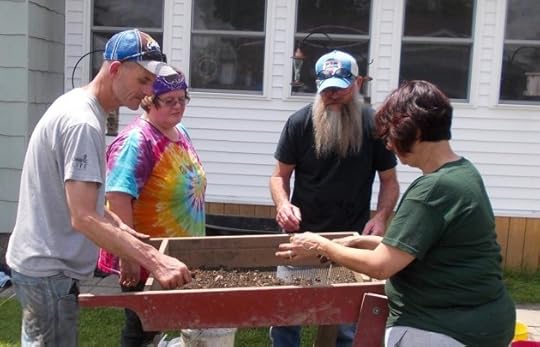 Archaeology is all about using evidence to answer questions that history has left us pondering. Sometimes it's as simple as 'where was Fort Dayton?' other times it can be as complex as 'what didn't the Doctor throw down the well?' A question that doesn't appear to have any limits.
Archaeology is all about using evidence to answer questions that history has left us pondering. Sometimes it's as simple as 'where was Fort Dayton?' other times it can be as complex as 'what didn't the Doctor throw down the well?' A question that doesn't appear to have any limits.
In 2002 Herkimer County Historical Society hosted an archaeological excavation in search of evidence of Fort Dayton and successfully uncovered artifacts from Colonial and Revolutionary War periods. After 12 years the Fort Dayton archaeological excavation was re-opened on May 31st, 2014 and after eight weeks of excavation the team recovered countless artifacts that helped fill in the history of Herkimer's Dr. Suiter but unfortunately failed to identify the location of the fort. A year later on May 30th the Herkimer excavation teams resumed the search at a new location.
Day 1
On the first day of the excavation after doing an initial site survey to establish a datum point and transit lines a volunteer surveyed the site using a metal detector to provide additional site information. The first shovel test pit established was the small well on the property that had been back-filled with compost in years prior, identified as STP #W. Volunteer Brian Doyle, son of Fred Doyle behind the first excavation, removed most of the back-fill by the end of the first day of digging. 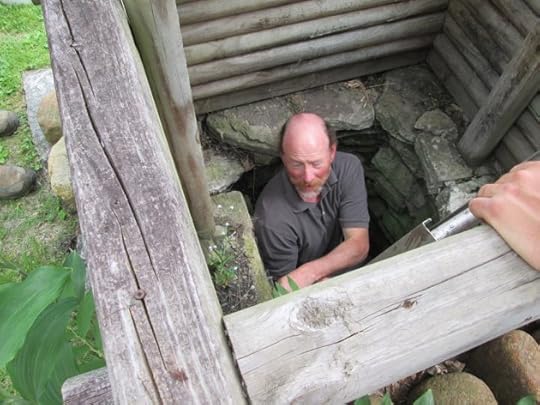
The second test pit established was STP #1 aproximately 7.5 meters from the datum point and in line with the well. This test pit proved to be more fertile as various sherds of ceramics, shards of glass and miscellaneous cut animal bones. The majority of artifacts were uncovered within the first two levels of test pit. The final excavation pit, STP #2, was another 7.5 meters from the datum point and unfortunately was densely packed with roots and slowed the excavation team dramatically. The test pit also proved fruitful with the first pipe stem recovered of the day.
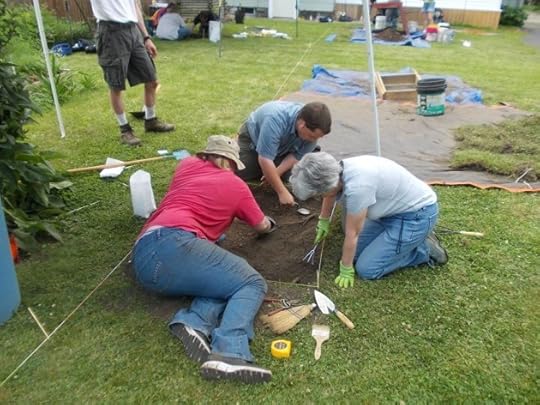
At the conclusion of the first week of the excavation the search for Fort Dayton at site number two has yielded more mid to late 19th century artifacts and a curious amount of cut and burned animal bones. The most significant artifacts recovered were obtained from test pit #1 and included a pipe stem, a large pipe bowl fragment several decorative buckles and ceramics.
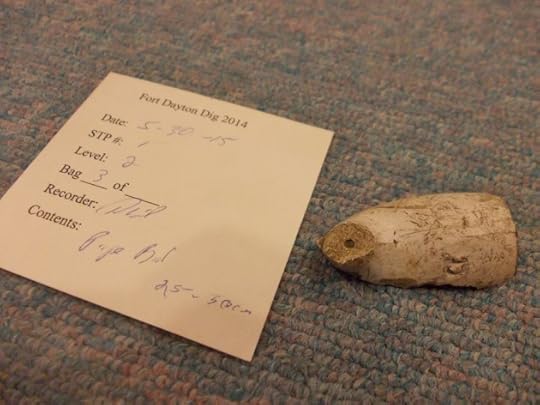
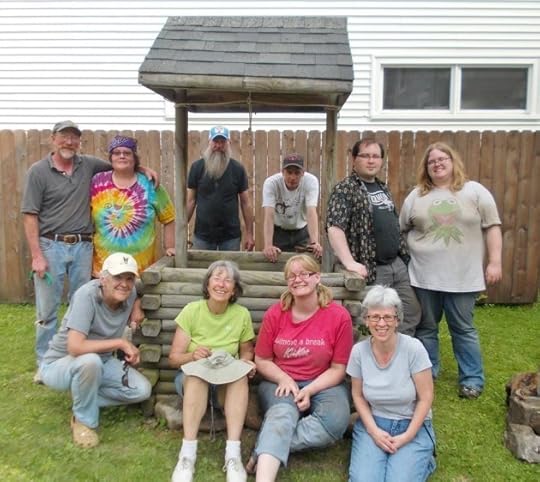 Caryl Hopson[/caption] If you're interested in archaeology you can contact the Herkimer County Historical Society about volunteering to help out at the excavation.
Caryl Hopson[/caption] If you're interested in archaeology you can contact the Herkimer County Historical Society about volunteering to help out at the excavation.
March 31, 2015
Exploring The Historic Utica Globe Mill ~ The Haunts And Legends Of New York
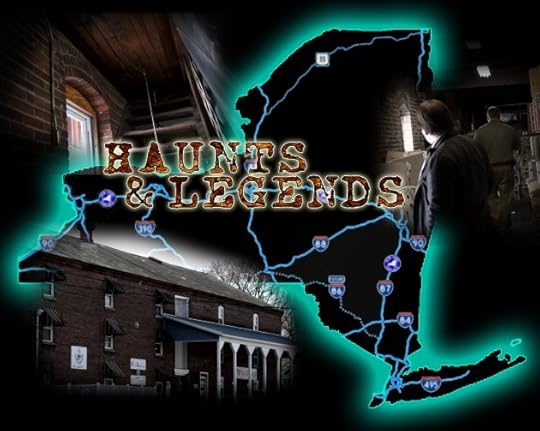
Steeped in history and legends, New York is filled with stories of the forgotten, eerie and the weird that influence us everyday.
Lite 98.7's Eric Meier has teamed up with Folklorist P.W. Creighton to explore the haunts and legends of New York. Through their travels into the dark and often overlooked spaces they will bring these historic sites back to life and make some unexpected discoveries along the way.
In this episode Phil guides the explorers to a former woolen mill in the heart of Utica to learn the dark history and chilling stories that persist to this day.
Originally founded in 1847, the Utica Globe Mill was constructed during the height of Utica's industrial growth and in 1855 it became the Utica Woolen Mills where it became a stable of Utica's industry until 1871. Today, the Utica Globe Mill is known as The Shoppes At The Finishline and while the industrial history may have been left behind it is still present not only in the architecture but the haunting activity that continues today.
Sometimes people who climb to the third floor claim to feel an unseen force keeping them from moving forward. During an investigation with a local group and a news station the reporter saw a shadow that looked like the little boy and was scratched at the same moment. Many investigations of the Mill have led to investigators having countless experiences and even capturing disembodied voices.
March 2, 2015
Facebook Adds New Suicide Prevention Feature To Posts
As cyberbullying grows, Facebook is taking action to by rolling out a new feature to its users.
The social media giant has seen many cases of cyberbullying over the years and has seen even more posts by people seeking help. Now, to show a different side to the internet Facebook is partnering with Now Matters Now, the National Suicide Prevention Lifeline, Save.org and Forefront: Innovations in Suicide Prevention to provide more options to users who see a friend post something concerning. Now when a user sees a friend post something concerning they have the option to click on the little arrow on the top right of the post and click "Report Post" where they will be given options to contact the friend who made the post, contact another friend for support or contact a suicide helpline. Facebook has had a feature to report potentially suicidal content since 2011 however, this is the first-time it has ever been integrated into the posts.
October 24, 2014
The Hauntings Of Historic Lansing Manor In North Blenheim

Lansing Manor is located in North Blenheim, NY, and a demonstration of what is possible when the historic value of a location is realized from an early date.
Lansing Manor was built by John Lansing Jr. in 1819, for his daughter and son in law. Lansing was the New York State representative in the Congressional Congress in 1787, and the Ratification Congress the following year. Lansing owned a vast amount of property in the area, so he built this federal style home so his daughter and son in law could serve as landlords for his tenants.
After they passed away, the house changed hands between a couple other families until it was purchased by the New York Power Authority in 1972, at which time the house was restored, and was furnished with authentic furniture from the early 1800's. The house is currently a museum today. Many old, and much loved, locations are occupied by the spirits of their former owners. There are reports of a ghostly lady wandering the house, phantom noises and even children's laughter from the surrounding grounds. Antiques can also increase this effect, as they also come with their own spirits.
August 26, 2014
A Tour Inside Utica's Old Main Psychiatric Center Hospital
 Phil Nye/TSM[/caption] The Old Main Psychiatric Center Hospital opened its doors to a public tour on Monday, August 25th at 5PM offering a crowd of more than 4 thousand an exclusive glimpse inside the historic iconic Utica landmark.
Phil Nye/TSM[/caption] The Old Main Psychiatric Center Hospital opened its doors to a public tour on Monday, August 25th at 5PM offering a crowd of more than 4 thousand an exclusive glimpse inside the historic iconic Utica landmark.
One of the most iconic historic landmarks in Utica is the 'Old Main' Utica Psychiatric Center Hospital. At more than 522 feet long, 52 feet deep and more than 48 feet high, the Old Main Psychiatric Center Hospital first opened its doors in 1843. The state hospital served the public until its closure in 1978. Over the years the Landmarks Society of Greater Utica has opened the doors of many of the historic landmarks to small public tours. Old Main last opened its doors in 2010 to a crowd of only 800 individuals that were given the opportunity to see inside the iconic landmark. The Landmarks Society was not prepared for the turnout that happened when they opened the doors to Old Main for a public tour on August 25th at 5PM.

Traffic was congested so badly around the Old Main Psych Center that it took better than 45 minutes to travel from Court Street to York Street with most averaging only a block in a half-hour after 5PM. Once on the property, the line for the tour stretched down the driveway of Old Main curving up the side of the building, continuing past the fences onto the lawns behind the building where parking was taking place up and down the rows of parked cars and ending somewhere back on the far side of the grounds. The line itself stretched for at least a quarter-mile.
After waiting in line for more than half-an-hour, we had moved closer to the building but still had not had the opportunity to see the front of the line which was still somewhere around the front of Old Main.

Interview With Landmarks Society
Continuing the journey after a 3 hour wait in line just to wind our way around to the front of Utica's Old Main Psych Center we were finally within sight of the grand entrance. Some participants suffered exhaustion waiting in line and emergency services were called however many individuals were eagerly anticipating the first glimpse inside the Utica landmark.
Interview With Tour Participants
Many were excited to see inside the iconic 'Old Main' Utica Psychiatric Hospital for the first time and despite the nearly 3 hour wait nearly 4 thousand individuals had the opportunity to see inside for the first time since 2010.
Tour Inside Utica's Old Main
Since the Utica Psychiatric Center 'Old Main' is still under the care of New York State and the Landmarks Society of Greater Utica, a great many individuals were forced to leave when the Mohawk Valley Psychiatric Center staff following regulations began to close the doors to the center at a little past 8PM. Landmarks Society worked to great length to keep attendees moving through the building but in the end the doors closed with many hundreds that waited hours in line still outside. The Landmarks Society Of Greater Utica had printed approximately 2,000 brochures explaining the history of the Utica State Hospital however, after only 30 minutes they had run out. It is estimated that there were more than 4,000 people in attendance and after the doors closed it is uncertain of when the building will permit its doors to be opened to the public again.
July 1, 2014
The Doctor's Forgotten Well Of Herkimer - Archaeology in Central New York

Archaeology is all about using evidence to answer questions that history has left us pondering. Sometimes it's as simple as 'where was Fort Dayton?' other times it can be as complex as 'what didn't the Doctor throw down the well?' A question that doesn't appear to have any limits.
In 2002 Herkimer County Historical Society hosted an archaeological excavation in search of evidence of Fort Dayton and successfully uncovered artifacts from Colonial and Revolutionary War periods. After 12 years the Fort Dayton archaeological excavation was re-opened on May 31st, 2014.
Day 7
On the seventh day of the excavation after uncovering the well-cap on Day 2, we continued to extract fill from what we have identified as 'The Suiter Layer' within the well and focusing on Test Pits 1, 9 &10. The 'Suiter Layer' continued to produce a large amount of medical artifacts including a number of intact medical vials and instruments in amazing condition. After resuming excavation within the well, our volunteer Brian Doyle, son of Fred Doyle behind the first excavation, began to uncover more even more intact artifacts beginning again with a number of medicine/apothecary bottles.
Where we had previously recovered a dozen or more we were now recovering them by the dozen. We also recovered parts to a cast iron stove, what looked to be components to Chlorine Batteries that Suiter used and most significantly was that of a revolver (pistol) grip with a raised design that was recovered from the well.


Excavation teams managed to recover more ceramics from surrounding test pits dating to the Colonial Era however, Test Pit 1 reached a sterile layer and the decision was made to close the pit by afternoon so volunteers could assist with excavating the remaining sites. As the afternoon progressed, the well reached a new level that produced more than 40+ intact medical bottles and paraphernalia. It is worth noting that we even recovered parts of a cast iron stove.
Day 8
On the eighth day of the excavation we began by recovering a glass 19th Century liquid soap dispenser and many more medical bottles and paraphernalia while our still operating test pits began to see a decline in artifacts recovered. Due to the sheer volume of artifacts and quality of those artifacts recovered from the well, many volunteers were re-tasked to assist with the efforts of the well by the afternoon.
While the excavation teams focused heavily on processing everything that came from the well in great quantities several volunteers continued to excavate at the remaining test pit and recovered leather-working tools, clam shells and ceramics that were indicative of the Colonial Era. A number of artifacts were recovered from the well of particular note including a clay horse & rider figurine, a series of sealed medical bottles, notably still sealed sutures of "sterilized silkworm gut," a cup and saucer, more apothecary bottles, medical glassware, ceramics and even a Doctor's leather pouch filled with still sealed medical vials.


The Ft. Dayton archaeological excavation began on May 31st with objective of expanding the 2002 excavation to uncover evidence of Fort Dayton, "The Forgotten Fort." The excavation has so far uncovered more than anyone thought possible. It uncovered a forgotten well with a cap stone that estimates place between 1740-1800 and countless artifacts. Through relative dating techniques the clay pipestems recovered have an average date of 1720-1800. These facts along with ceramics indicate that the site is very likely Ft. Dayton property or even likelier, the site (well) pre-dates the Fort.

While the excavation is an attempt to identify the Forgotten Fort it has had the side effect of providing immeasurable insight into the life and practice of one of Herkimer's most historic doctors. Dr. Suiter had a very diverse skill set and practice.
Phase 1 of the Fort Dayton concluded with a completely different result than we could have ever expected. In searching for trace evidence of "The Forgotten Fort Dayton," we had uncovered a Victorian Era (1800's) well that has greatly helped expand on our knowledge of a local doctor instead. Many artifacts are helping provide insight into the practicing life of Dr. Suiter and his property.
Phase 2 of the Fort Dayton excavation uncovered even more about Dr. Suiter's practice and personal life and more Revolutionary War era artifacts that some evidence of the forgotten fort.
Phase 3 of the Fort Dayton excavation will focus on continuing the excavation of the active test sites and the well to uncover more information about Dr. Suiter and hopefully we will uncover some more definitive evidence of the forgotten fort. Of course, this phase will also intensely focus on processing and accessioning all that has been recovered in the past five weeks of the dig as well....

If you're interested in archaeology you can contact the Herkimer County Historical Society about volunteering to help out at the excavation.
June 26, 2014
Down The Forgotten Well Of Herkimer - Archaeology in Central New York

Archaeology is all about using evidence to answer questions that history has left us pondering. Sometimes it's as simple as 'where was Fort Dayton?' other times it can be as complex as 'what didn't the Doctor throw down the well?'
In 2002 Herkimer County Historical Society hosted an archaeological excavation in search of evidence of Fort Dayton and successfully uncovered artifacts from Colonial and Revolutionary War periods. After 12 years the Fort Dayton archaeological excavation was re-opened on May 31st, 2014.
Day 5
On the fifth day of the excavation after uncovering the well-cap on Day 2, we continued to extract fill from what we have identified as 'The Suiter Layer' within the well as the furthering the excavation on the surrounding test pits. The 'Suiter Layer' is named after Dr. A. Walter Suiter who owned the property and constructed the 'Suiter Building' in 1884 that served as his practice until his death. The layer is so nicknamed because of the large amount of medical artifacts that have been recovered from the layer of fill in the well.

After resuming excavation within the well, our volunteer Brian Doyle, son of Fred Doyle behind the first excavation, began to uncover more intact artifacts beginning with a number of medicine/apothecary bottles. The most significant finds were an intact N.A. White & Son Stoneware Jug from Utica, a Borolyptol bottle and a 'German Syrup' bottle that placed our date somewhere between Mid to late 1800's. Excavation teams managed to recover more ceramics from surrounding test pits including pipe stems that allowed the lab teams to provide a relative date to the sites between 1750-1800. One of the more interesting finds retrieved from the well was an intact gas lamp along with what looked to be a barrel seal.
Day 6
On the sixth day of the excavation we began to retrieve many Colonial Era artifacts from two of our other test pits while we continued to excavate the 'Suiter Layer' from the well. While the excavation teams uncovered more ceramics, glassware, and even intact pipe bowls the team working on the well recovered even more intact ceramics, glassware and even began to recover larger artifacts including the remains of hat, brass curtain rods, more apothecary bottles, medical glassware and ceramics. One of the greatest discoveries of the day was a near-intact pipestem/pipe that was recovered from a test pit surrounding the well.


Phase 1 of the Fort Dayton concluded with a completely different result than we could have ever expected. In searching for trace evidence of "The Forgotten Fort Dayton," we had uncovered a Victorian Era (1800's) well that has greatly helped expand on our knowledge of a local doctor instead. Many artifacts are helping provide insight into the practicing life of Dr. Suiter and his property. Phase 2 of the Fort Dayton excavation has begun to uncover more Revolutionary War era artifacts and hopefully we will uncover some evidence of the forgotten fort. If you're interested in archaeology you can contact the Herkimer County Historical Society about volunteering to help out at the excavation.
June 9, 2014
The Forgotten Well Of Herkimer - Archaeology in Central New York

When it comes to exploring history nothing is more 'hands on' than historical archaeology. The funny thing is, nothing ever goes quite how you'd expect with an excavation.
In 2002 Herkimer County Historical Society hosted an archaeological excavation in search of evidence of Fort Dayton and successfully uncovered artifacts from Colonial and Revolutionary War periods. After 12 years the Fort Dayton archaeological excavation was re-opened on May 31st, 2014.
Day 3
On the third day of the excavation after uncovering the well-cap on Day 2, we opened up two additional test pits to explore the far side of the well, additionally we began to excavate the back-fill from inside the well. Due to the design of the cap-stone and the fact that it was hand-hewn, we were able to establish that the stone dated between 1740 and 1800.  After moving well back-fill for the majority of the day our volunteer Brian Doyle, son of Fred Doyle behind the first excavation, began to uncover intact artifacts beginning with a ceramic pitcher that had a pristine kite-mark that dated the vessel to the mid-1800's.
After moving well back-fill for the majority of the day our volunteer Brian Doyle, son of Fred Doyle behind the first excavation, began to uncover intact artifacts beginning with a ceramic pitcher that had a pristine kite-mark that dated the vessel to the mid-1800's. 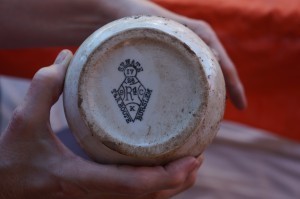
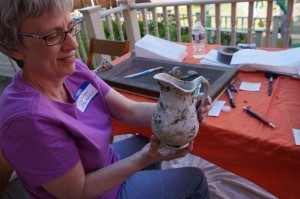
Excavation teams managed to recover more ceramics from surrounding test pits including pipe stems that would allow the lab teams to provide a date to the sites. However, after finding dated ceramics and an actual marker stone, we could definitely say that we had reached a mid-1800s and chronologically correct layer within the well. One of the more interesting finds retrieved from the well was an intact medicine bottle with liquid still sealed inside. 
Day 4
On the fourth day of the excavation we conclude the excavation of test pit 4 after hitting a sterile layer. In return we opened up STP #1 which had previously shown artifacts from the Colonial Era. While the excavation teams uncovered more ceramics, glassware, and even intact pipe bowls the team working on the well recovered even more intact ceramics, glassware and even began to recover intact laboratory glassware in the form of glass slides, medicine bottles, pipettes and much more. In fact, the well team were recovering so many artifacts the cleaning and accessioning teams weren't able to keep up.

Phase 1 of the Fort Dayton concluded with a completely different result than we could have ever expected. In searching for trace evidence of "The Forgotten Fort Dayton," we had uncovered a Victorian Era (1800's) well that has greatly helped expand on our knowledge of a local doctor instead. Many artifacts are helping provide insight into the practicing life of Dr. Suiter and his property.

Phase 2 of the Fort Dayton excavation should bring us down to the Revolutionary War era and hopefully we will uncover some evidence of the forgotten fort. If you're interested in archaeology you can contact the Herkimer County Historical Society about volunteering to help out at the excavation.
June 2, 2014
The Excavation of Forgotten Fort Dayton - Archaeology in Central New York [VIDEO, PHOTOS]

When it comes to exploring history nothing is more 'hands on' than historical archaeology. Through hard work and shovel-fulls of of dirt through a screen a forgotten Fort has come back to life.
Archaeology is generally one of those degrees that makes you wonder what you were thinking, especially as an undergraduate degree. I did my fieldwork at a Revolutionary War era site, Fort Edward and focused on Geo-Archaeology but there's never really been a call to break out that knowledge. Unless you want to work state/federal or for a Contract Resource Management firm and take a 6 week excursion to who knows where for once a year and be done (out of a job after 6 weeks) archaeology outside of University just isn't a big demand. It's extensive back-breaking, sun-burning labor that takes hours to dig down a few centimeters.
After a program with the Herkimer County Historical Society in late 2013, Executive Director Sue Perkins and Caryl Hopson noted that I had a degree in archaeology and asked if I would be interested in helping them re-open the Fort Dayton excavation that had taken place in 2002. Fort Dayton, known as 'The Forgotten Fort,' was constructed in 1776 under the supervision of Colonel Elia Dayton as part of the defensive chain of forts through the Mohawk Valley as the western frontier. While no significant events occurred at the fort itself, it is best noted as the Fort that supplied the militia that General Herkimer led into battle to relieve Fort Stanwix and after Stanwix burned Fort Dayton was known as the western-most point of the frontier.
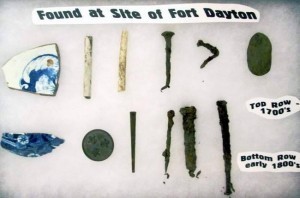 Caryl Hopson/Herkimer Historical Soc.[/caption] A historical society volunteer, Fred Doyle, who had conducted extensive research on what was known as "The Forgotten Fort" and together with the historical society and archaeologist Doug Pippin had managed to put together a brief excavation to search for the forgotten Fort Dayton in 2002. Their excavation uncovered a number of artifacts including some pipe stems, glassware and ceramics. The artifacts seemed period and were worthy of further research but after Doyle passed in 2003, the Fort was forgotten again. When the Herkimer County Historical Society wanted to resume the excavation for Fort Dayton it was an easy answer.
Caryl Hopson/Herkimer Historical Soc.[/caption] A historical society volunteer, Fred Doyle, who had conducted extensive research on what was known as "The Forgotten Fort" and together with the historical society and archaeologist Doug Pippin had managed to put together a brief excavation to search for the forgotten Fort Dayton in 2002. Their excavation uncovered a number of artifacts including some pipe stems, glassware and ceramics. The artifacts seemed period and were worthy of further research but after Doyle passed in 2003, the Fort was forgotten again. When the Herkimer County Historical Society wanted to resume the excavation for Fort Dayton it was an easy answer.
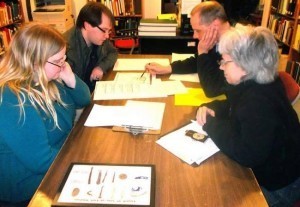 After meeting to review the previous excavation for Fort Dayton we decided that it would be best to expand the Shovel Test Pits (STP), archaeology speak for digging a small hole, into excavation pits at the sites were the majority of the artifacts had been recovered from previously.
After meeting to review the previous excavation for Fort Dayton we decided that it would be best to expand the Shovel Test Pits (STP), archaeology speak for digging a small hole, into excavation pits at the sites were the majority of the artifacts had been recovered from previously.
Working with Herkimer County Historical Society, we assembled an excavation program plan and held an interest meeting on May 17th. Much to our surprise we received more than 40 volunteers eager to help with the excavation of Fort Dayton. And on May 31st the archaeological excavation of Fort Dayton resumed.
Day 1
On the first day of the excavation volunteers helped mark-off the STPs, test pits, that we wanted to expand based on the previous results while additional volunteers worked to accession the results from the 2002 excavation inside. After a few hours the teams had managed to process a number records while the excavation teams began uncovering artifacts. 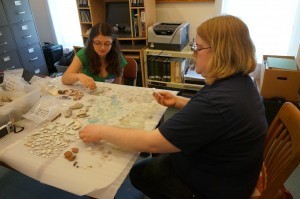
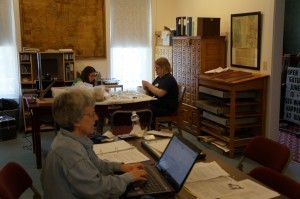
Excavation teams managed to recover a number of ceramics including pipe stems that would allow the lab teams to provide a date to the sites and after using relative dating methods the accessioning team identified the majority of our pipe stems dated the site between 1720 and 1750. The most interesting find of the day was however, an interesting cornerstone. According the the results from the earlier excavation, they believed it to be a foundation stone or cornerstone of some form. It was clear that there was something else to the stone. This site would need to be expanded on the second day of the excavation.

Day 2
On the second day of the excavation we expanded the test pit to include 3 additional test pits in hopes of uncovering whatever this structure/stone was and providing some context. While the excavation teams uncovered more ceramics, glassware, and even intact pipe bowls the team working on the stone pits discovered something else. The discovery of the large well-cap and subsequent well, based on the size and design may in-fact indicate that it is the old Fort Dayton well. As our historian searched through the records she has just recently discovered that there is a mention of an old well in the deed to the Suiter building. The excavation is continuing onward to recover any further information on the well, property and hopefully we will be able to identify the structure and the time period to which it belongs.
April 1, 2014
Spring Giveaway PT II
As a gift for everyone the North Shore series' new release, "Sunglasses At Night" is going to be available for FREE for a limited time to celebrate the release. So please bounce on over to Amazon and download your copy today and make sure to share with everyone.
Click Here To Get A Free Copy Between April 4th and April 6th On Amazon and please share with everyone.
Make sure to grab your copy and rate & review if you can.
Always the Bad Guy To Someone Else...

North Shore Sheriff's department has failed again but this time they've come under fire for the recent tragedy. A Senator's daughter is dead after all.
Logan is trying his best to keep the secret and deal with the loss but his new dream girl is not one to leave things alone. As he'll soon find out, she's not exactly who she pretends to be either.
Everyone has secrets but who is willing to expose them?





